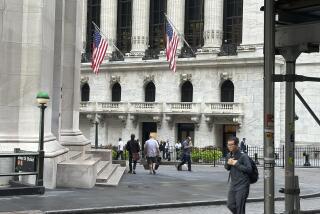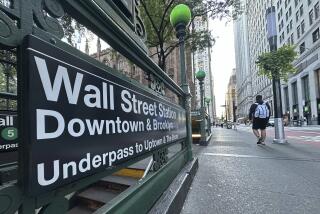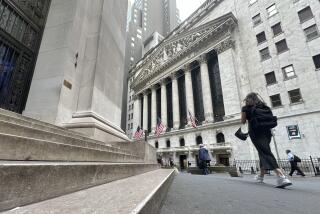What’s behind stocks’ slide?
- Share via
Time to poke your head out of the foxhole.
Wall Street ended a painful eight-day losing streak on Wednesday with a modest gain. The Dow Jones industrial average closed up 29.82 points, or 0.3%, to 11,896.44, rallying from an early decline of as much as 165 points.
All told, the Dow has fallen nearly 830 points, or 6.5%, in less than two weeks.
Here are answers to some of the questions dazed investors may have about what has happened.
Why did the market hit such a severe losing streak?
It was a perfect storm: With Congress deadlocked last week on raising the federal debt ceiling, some investors were spooked about a possible U.S. default.
At the same time, the market was stunned by the weakness in some key U.S. economic reports, including the government’s estimate of first-half growth.
Finally, Europe’s government-debt crisis worsened again, further undercutting confidence about the global economy.
Some analysts said it wasn’t a mad rush for the exits that pushed share prices down so quickly, but a simple lack of buyers.
“It was as much a ‘buyer’s strike’ as anything,” said Rick Bensignor, market strategist at Dahlman, Rose & Co. in New York. As sellers tried to exit, they found few takers, forcing them to slash their asking prices for stocks.
What about the effect of computer-driven trading?
As usual, that helped stoke the slide once it got going.
Some investors’ machines are programmed to bail out of the market if key indexes fall to preset levels. “Their models force them to sell,” said Phil Roth, a veteran “technical” market analyst at Miller, Tabak & Co. in New York.
A critical level for the benchmark Standard & Poor’s 500 index was about 1,286, its 200-day moving average. That’s a rolling tally of the index’s level over the last 200 trading days. When the S&P tumbled below that level on Tuesday, the sell-off deepened in a hurry, and the index lost 2.6% for the day, its worst drop in a year.
Could this be the start of a much worse decline?
It’s possible, but no one can say that with certainty.
To put this sell-off in perspective, major indexes are down less than 10% from their multiyear highs reached in the spring. In Wall Street lingo, a normal “correction” in a bull market, meaning a temporary decline on bad news, can shave 10% to 20% off share prices.
It usually takes a sustained decline of more than 20% for analysts to declare that a new bear market has begun.
In spring 2010, the S&P 500 fell 16% as the U.S. economy slowed and Europe’s debt woes worsened, similar to the backdrop now. Stocks turned up again later that summer as the economy improved and the Federal Reserve said it would loosen credit further.
This time around, the S&P fell 8% from its spring high of 1,363.61 on April 29 to 1,254.05 on Tuesday, before inching up 0.5% to 1,260.34 on Wednesday.
So the sell-off, so far, is only half as bad as last year’s correction.
Just how weak is the economy? Is a new recession possible?
That’s what many investors are trying to figure out.
Late last week, the government estimated that the economy grew at a paltry 1.3% annualized rate in the second quarter. The closer growth skirts to zero, the greater the fear of recession.
Data in the last few days on manufacturing activity and consumer spending also have been weak.
But a report Wednesday on private-sector hiring estimated that companies added a net 114,000 jobs last month, a low number but still more than expected.
The more important number is due Friday: the government’s estimate of employment growth across the economy. Analysts are looking for a gain of just 85,000 jobs. A much softer number could cause recession fears to swell.
Roth figures that, at best, stocks could struggle for the rest of this year and into 2012 unless the economy improves. “I don’t think you can have a bull market if people are questioning global growth,” he said.
What else is Wall Street worried about?
The never-ending debt crisis in Europe is high on the list again.
Less than two weeks ago, the European Union agreed on a new bailout of Greece. One goal of the EU package was to boost confidence that debt-hobbled Italy and Spain wouldn’t follow Greece, Portugal and Ireland in needing full bailouts.
But worries about Italy and Spain have mushroomed over the last week, pummeling their stock markets and driving up interest rates on Italian and Spanish government bonds.
Italy is the euro-zone’s third-largest economy. If it could no longer afford to borrow in the private market, the cost of a bailout could be more than the rest of Europe could afford.
That might not matter to the U.S. except that a financial crisis in Europe’s biggest economies inevitably would hurt the continent’s banks, said Gail Dudack, head of Dudack Research Group in New York. And because those banks have ties to other banks worldwide, financial contagion could quickly spread — just as it did in the fall of 2008 from U.S. banks.
A worsening European debt crisis “goes straight to the question of the health of the global banking system,” Dudack said.
What about corporate earnings — haven’t they been strong?
Yes, at least for many multinational firms. But second-quarter data now are ancient history. The question is whether earnings will continue to rise, and that will depend on global economic growth.
Would it be smart now to sell stocks and buy bonds, or just keep money in the bank?
If you have money you absolutely can’t afford to lose, it should never be in stocks. Go to the bank.
Bonds are safer than stocks because they’re less volatile. But the problem now with buying bonds is that yields are so low, at least for high-quality issues such as U.S. Treasuries. A five-year T-note pays just 1.26% annual interest, down from 1.69% in mid-June.
“You only buy bonds at these levels if you think a recession is coming,” said Gary Pollack, head of bond trading at Deutsche Bank Private Wealth Management in New York.
If the economy manages to muddle along, or picks up speed, some stocks may do quite well. If you have nothing invested in equities, you won’t benefit if this turns out to be just a short-term market pullback.
More to Read
Inside the business of entertainment
The Wide Shot brings you news, analysis and insights on everything from streaming wars to production — and what it all means for the future.
You may occasionally receive promotional content from the Los Angeles Times.










